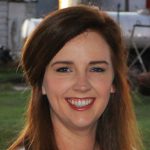For many students, going to the zoo for a school function is normally a field trip. However, for students at Blue Springs South and Blue Springs High School, they have the unique opportunity to receive a behind the scenes look at the Kansas City Zoo in Missouri. The FFA advisors, Craig Zwahlen and Morgan Payton, have worked with the zoo for the past four years to provide their students with an opportunity of a lifetime.
Four years ago, the Kansas City Zoo reached out to the Blue Springs School District to talk husbandry at the zoo. The Blue Springs ag classes helped with a project to help redesign the elephant sanctuary and adapt the exhibit to be more forward thinking. That formed a great working connection with the zoo administration. From there, Craig and Morgan were asked to come back to teach a summer school zoology class that would count as college credit hours for their students.
FFA advisor at Blue Springs South, Craig Zwahlen said, “The zoo is more than just a zoo. It really is an educational tool to monitor behaviors and help keep some of these animals from going extinct.”
The classes include two courses that are both two weeks long: Zoo 101 and Zoo 201. The classes are available for incoming juniors and seniors, or with a teacher recommendation. This referral system allows students who are not enrolled in the ag program to have an opportunity to pursue an animal science interest. Craig says the cool thing about this option is those students typically end up joining the program and add ag classes in their schedule for the next year.
The classes cover conservation methods, breeding practices, and genetics. Zoo 101 covers conservation practices in line with the Species Survival Plans since the Kansas City Zoo is a part of the Association of Zoos and Aquariums.
During Zoo 101, students get to visit many places that the public normally does not have access to, such as the building where the meals are prepared for the animals. The second week of Zoo 101, the students study the different methods of collecting behavior data on certain animals as selected by the instructors. The students dive deep into creating a more natural environment for the animals.
Craig says, “We talk about different types of strategies to collect data, like quadrat and scan samplings. The class looks at different behaviors of how we can better manipulate the environment for animals at the zoo to make it more natural.”
In Zoo 201 the students cover genetics and adaptations the animals have developed to survive in the wild. The students learn more about a phylogenetic tree, which dives into evolution and where things come from. For example, the class looks at gorillas, lions, and cheetahs. Students study the groups and must select which two are the best to mate within the group and has the best genetic diversity.

In addition to the genetics, students also have the unique experience of looking at crimes and investigating a makeshift wildlife crime scene. Criminal investigators from different departments in the Kansas City metro come in and present to the class. The students have to figure out what the crime is and how to solve it by looking at things like blood sampling and foot prints. The situation is handled like a real-life wildlife investigation.
For those students who participate in the classes, they have the opportunity to go behind the scenes of many exhibits. For example, students get to see everything that goes on in the polar bear, penguins, plains barn, elephant barn, nutrition/food prep areas, and the animals housed in the Australia barn. Although they are not allowed to take pictures, students are able to see all the of the hard work that it takes behind the scenes to run a successful zoo.
For the past three years, Craig and Morgan have been teaching the zoology classes at the Kansas City Zoo. This opens up doors for the students and allows them to get a foot in the door in a unique career. Craig loves the experience and opportunities the zoo presents for his students. Craig said, “Overall, there are so many entities of this class that makes it unique, yet so beneficial for students like mine that are in more of an urban ag program. Probably 98 percent of my kids want to go into animal science, but they don’t have the farm land out there as a resource. Our SAE’s are totally different but that’s what makes our program unique.”



